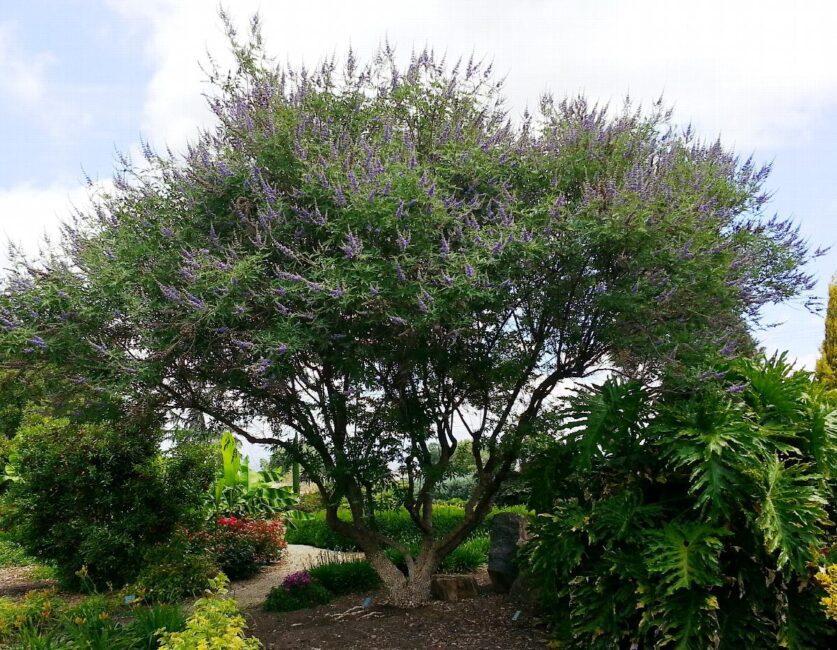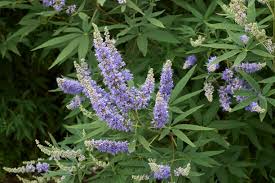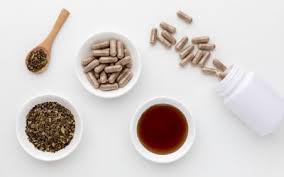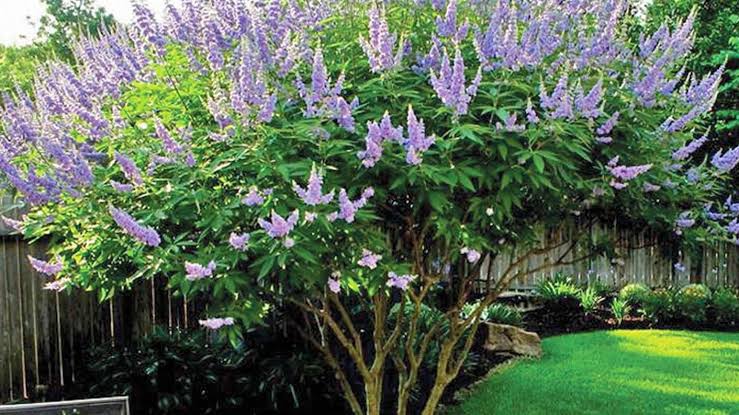Chaste Tree, also known as Vitex agnus-castus, is a remarkable and beneficial plant that has been cherished for its medicinal properties for centuries. This beautiful shrub, native to the Mediterranean region, is adorned with spikes of fragrant lilac or violet flowers and bears palmate leaves. Its historical significance in herbal medicine and its modern applications make it an intriguing botanical specimen.
The chaste tree’s history dates back to ancient Greece and Rome, where it was highly regarded for its potential to support women’s health. It was believed to be a symbol of chastity, hence its name. In fact, it was often used by monks in the Middle Ages to help them maintain celibacy, earning it the moniker “monk’s pepper.”
One of the most notable uses of chaste tree is in the realm of women’s health. It has been traditionally employed to alleviate a variety of female hormonal imbalances and menstrual disorders. Chaste tree’s ability to influence the pituitary gland, which regulates hormone production, has made it a valuable tool in addressing conditions like premenstrual syndrome (PMS) and irregular periods. It can help balance estrogen and progesterone levels, leading to more harmonious menstrual cycles.
Moreover, chaste tree has been explored for its potential role in easing the discomfort associated with menopause. Women experiencing hot flashes, mood swings, and other menopausal symptoms have turned to this botanical remedy for relief. Its hormone-balancing properties can help mitigate some of the challenges women face during this transitional phase of life.
Chaste tree is not only beneficial for women but also for men. It has been used in traditional medicine to address conditions related to the male reproductive system. Some men have found relief from benign prostatic hyperplasia (BPH) symptoms, such as frequent urination, by incorporating chaste tree into their healthcare routines.
Beyond its hormonal influence, chaste tree boasts an array of other health benefits. Its anti-inflammatory and antioxidant properties make it a valuable ally in combating oxidative stress and inflammation within the body. Some studies have even suggested its potential in managing skin conditions like acne, thanks to its hormone-balancing effects.
In the realm of herbal medicine, chaste tree is typically consumed in the form of tinctures, capsules, or teas. However, it’s important to use this botanical under the guidance of a qualified healthcare practitioner, especially when addressing specific health concerns.
In addition, the chaste tree, with its rich history and diverse range of applications, stands as a testament to the enduring power of nature in promoting human well-being. Its gentle yet effective influence on hormonal balance has made it a cherished herbal remedy for generations. Whether you’re a woman seeking menstrual harmony or someone looking to support their overall health, the chaste tree is a botanical treasure worth exploring.
Read Also: Everything You Need To Know About Herb Farm
Growing the Chaste Tree

Growing a chaste tree (Vitex agnus-castus) can be a rewarding experience, as it not only adds beauty to your garden but also provides potential health benefits through its aromatic blooms and leaves. Below are the essential steps and considerations for successfully cultivating this unique shrub.
1. Climate and Location: Chaste trees thrive in regions with a Mediterranean climate, characterized by mild, wet winters and hot, dry summers. They are also adaptable to various soil types but prefer well-draining soil.
2. Planting Time: The best time to plant a chaste tree is in the spring or early summer when the weather is warm and frost is no longer a concern. This gives the plant time to establish its root system before winter.
3. Selecting a Site: Choose a sunny location for your chaste tree. These plants require at least 6-8 hours of sunlight per day to flourish.
4. Soil Preparation: Ensure the soil is well-draining to prevent waterlogged roots. Amending the soil with organic matter, like compost, can improve drainage and provide nutrients.
5. Planting: Dig a hole that is slightly larger than the root ball of the chaste tree.
Place the plant in the hole at the same depth as it was in its container. Fill the hole with soil and water thoroughly to settle the soil.
6. Watering: Chaste trees are drought-tolerant once established, but they benefit from regular watering during the first growing season. After that, water deeply but infrequently to encourage deep root growth.
7. Mulching: Apply a layer of mulch around the base of the tree to help retain soil moisture and regulate soil temperature. Keep the mulch away from the trunk to prevent rot.
8. Pruning: Pruning is generally not required for chaste trees unless you want to shape or control their size. If pruning is necessary, do so in late winter or early spring before new growth begins.
9. Fertilizing: Chaste trees are not heavy feeders. Fertilize sparingly with a balanced, slow-release fertilizer in the spring.
10. Pest and Disease Management: Chaste trees are relatively pest and disease-resistant. However, keep an eye out for aphids, spider mites, or scale insects, which can occasionally infest the plant. Treat as needed with appropriate remedies.
11. Harvesting: If you wish to use the chaste tree for its medicinal properties, you can harvest the leaves and flowers in late summer or early fall when they are in full bloom. Dry them for later use.
12. Winter Care: Chaste trees are generally hardy, but in regions with harsh winters, you may want to protect young plants with a layer of mulch or frost cloth to prevent frost damage.
By following these steps and providing proper care, you can enjoy the beauty of a chaste tree in your garden while potentially benefiting from its herbal properties. Remember that patience is key when growing chaste trees, as they may take a year or two to establish themselves fully and begin flowering.
10 Health Benefits of Growing Chaste Tree
Chaste Tree (Vitex agnus-castus) is associated with several potential health benefits, primarily due to its influence on hormonal balance. Here are 10 health benefits of chaste tree:
1. Menstrual Health: Chaste tree is often used to alleviate menstrual irregularities. It can help regulate menstrual cycles, reduce heavy bleeding, and ease menstrual pain and discomfort.
2. Premenstrual Syndrome (PMS): Chaste tree is known to relieve the symptoms of PMS, including mood swings, breast tenderness, and bloating, by balancing hormonal fluctuations.
3. Menopause Support: Some women find relief from menopausal symptoms such as hot flashes, mood swings, and sleep disturbances when using chaste tree supplements.
4. Hormone Balancing: Chaste tree can help balance estrogen and progesterone levels in the body, making it useful for conditions characterized by hormonal imbalances.
5. Fertility Enhancement: It is believed that chaste tree can enhance fertility by promoting regular ovulation and improving the chances of conception.
6. Acne Management: Due to its hormonal regulation properties, chaste tree may be beneficial for managing hormonal acne in some individuals.
7. Breast Pain (Mastalgia): Women experiencing breast pain related to hormonal changes may find relief from this discomfort by using chaste tree.
8. Fibrocystic Breast Disease: Chaste tree has been explored as a potential treatment for fibrocystic breast disease, a condition characterized by the development of noncancerous lumps in the breasts.
9. Benign Prostatic Hyperplasia (BPH): Some men have used chaste tree supplements to alleviate the symptoms of BPH, a condition that affects the prostate gland and can lead to urinary issues.
10. Stress and Anxiety Reduction: Chaste tree may indirectly support mental health by helping to regulate hormonal fluctuations, which can contribute to reduced stress and anxiety in some individuals.
It’s important to note that while chaste tree has been used traditionally for these purposes, scientific research on its effectiveness is ongoing, and individual responses can vary. If you are considering using chaste tree for specific health concerns, it’s advisable to consult with a healthcare professional for personalized guidance and dosage recommendations.
Additionally, herbal supplements should be used with caution and under supervision, especially if you are pregnant, breastfeeding, or taking other medications.
Read Also: Everything You Need To Know About Herbalism
Chasteberry

Chasteberry, also known as Vitex agnus-castus, is a special and useful plant that people have used for a long time. This plant is good for many things, and it is not hard to understand why so many like it.
Chasteberry is a plant that grows in places with nice weather, like the Mediterranean. It is a bushy plant with pretty lilac or purple flowers and leaves like hands. People have liked it for hundreds of years because they believe it can do good things for our bodies.
Chasteberry is often used to help women. It can help women who have problems with their periods. Some women have periods that don’t come when they should, or they have too much pain. Chasteberry can make periods more regular and not so painful. It can also help women who have problems when they stop having periods, which is called menopause. Chasteberry may make hot flashes and mood swings not so bad.
Chasteberry is like a helper for our hormones. Hormones are like little messengers in our bodies that tell it what to do. Chasteberry helps these messengers work together better. This can be good for both women and men. Men can use it to feel better if their prostate is too big and gives them trouble.
Some people, especially young ones, have trouble with their skin. They get pimples and acne that can be not so nice. Chasteberry might help because it helps balance hormones. When hormones are in balance, the skin can be happier.
Most of the time, Chasteberry does not make problems. But, like with many things, it’s good to be careful. If you are having a baby or taking other medicines, talk to a doctor before using it. A doctor can tell you if Chasteberry is a good idea for you.
Chasteberry is a plant that people have liked for a long time. It helps women with their periods and menopause. It can also make skin look better. But always talk to a doctor before trying it, just to be safe. Chasteberry is a natural helper that many people have found to be very useful.
Chasteberry Supplement

Chasteberry supplement is a way to use the power of the Chasteberry plant to support your health. These supplements come in different forms like pills, capsules, or liquid extracts, and they are designed to give you the benefits of Chasteberry in an easy and convenient way.
A Chasteberry supplement contains extracts from the Chasteberry plant. This means that the helpful parts of the plant are taken out and put into a form you can take as a supplement. These supplements are usually made from the fruit of the Chasteberry plant because that’s where many of the good things are.
Chasteberry supplements are thought to work by helping to balance hormones in your body. Hormones are like messengers that tell your body what to do. Sometimes they can get a bit mixed up, especially in women. Chasteberry helps these hormones work together better, which can make your body work better too.
Chasteberry supplements are often used to help with different things:
1. Period Problems: If you have irregular periods or painful periods, Chasteberry might make them better.
2. PMS: Chasteberry can also help with the symptoms of PMS like mood swings, breast tenderness, and bloating.
3. Menopause: Some women use Chasteberry to make menopause symptoms like hot flashes and mood swings not so bad.
4. Skin Troubles: Chasteberry’s hormone-balancing effects might also help with skin problems like acne.
Using Chasteberry supplements is pretty simple. You just follow the directions on the label, which will tell you how much to take and how often. It’s usually a good idea to take them with food to avoid stomach upset.
While Chasteberry supplements are natural, it’s still important to be careful. If you’re pregnant, breastfeeding, or taking other medicines, it’s a good idea to talk to a doctor before using Chasteberry supplements. They can help you decide if it’s right for you and if it might interact with other things you’re using.
In conclusion, Chasteberry supplements are a convenient way to get the benefits of this helpful plant. They can support women’s health by balancing hormones and may help with period problems, PMS, menopause, and even skin issues. Just remember to use them carefully and consult a healthcare professional if you’re unsure about whether they’re right for you.

